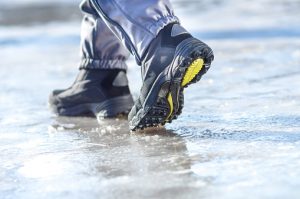WITH THE WINTER, COMES SNOW, ICE AND SLIP AND FALL ACCIDENTS
 With the winter season, generally comes snow and ice, and in turn, slip and falls resulting in broken bones, torn up knees, and head and neck injuries. Keep in mind, these cases are hard to win for the victim, but our firm has experience, and we have had some recent success stories.
With the winter season, generally comes snow and ice, and in turn, slip and falls resulting in broken bones, torn up knees, and head and neck injuries. Keep in mind, these cases are hard to win for the victim, but our firm has experience, and we have had some recent success stories.
The basic elements of the slip and fall claim, which determine whether you have a winnable case.
- Property owners generally have a reasonable amount of time to clear snow or ice, or to salt and sand an area that the public or invitees use after the weather event. However, they can also take precautions in advance, such as putting sand or ice-melt down ahead of the event or storm. Some jurisdictions have laws on the books instructing that the owner of commercial or residential property has a certain number of hours to clear his/her/its walkways after the storm ends.
- Playing into point number 1, is that property openers should have some system in place for monitoring upcoming weather events - such as snow or ice storms, or even rain - that after falling, combined with overnight freezing temperatures, can turn into ice.
- Property owners also need to be aware of what we call the thaw-refreeze event. This occurs, when it has snowed, and the owner plows or treats the snow accumulation; the snow pack l then melts during the day, and the water run-off flows to various areas of the property which are used as paths or walkways. Overnight, temperatures drop below freezing and as a result, the water or run-off from the melt, turns to ice again and a creates danger for morning walkers or traffic walking over the area if not treated. Therefore, owners and building managers have to constantly monitor weather conditions, including temperature changes, and inspect the property for new areas of ice or refreezing each day at reasonable intervals.
- Man-made ice: In some cases, the property owner or its staff create the ice or snow, without precipitation or a snow storm even occurring. How many times have we seen property management personnel hosing down the sidewalk to sweep away debris in the morning or watering the plants. Well, if that water turns into ice, and the property manager does not take steps to treat the area, it may have just exposed itself to a negligence claim from anybody who slips and falls (but see, Assumption of Risk discussion below)
The Victims' Duties and Assumption of Risk:
- The Rule of Assumption of the Risk: Assumption of the risk is usually applied to visible ice and snow. It is a complete bar to a claim. The law is and remains that in order to assume the risk of falling due to ice or snow or any hazard, you had to be able to see it, or you either knew or should have known it was there based upon the circumstances. If you see the snow or ice or should have seen it, and you decide to walk on it, and then fall, you cannot make a successful claim against the owner or person in charge of the property because you took the risk of falling by walking over or on a known hazard. The exception to these situations is generally where you have no choice but to walk over the area. For example, you have to walk over snow or ice in order to leave your apartment or location, and there is no other safe route available to you to get to where you are going, such as your car, but keep in mind, many courts have held that you must have good reason for venturing out in the first place (e.g. had to go to work).
The bottom line is that if you should see the hazard or icy area and you choose to expose yourself to it for no good reason, you will lose, even if you sustain an injury.
The "Black Ice" Exception:
Black ice is generally defined as ice that is invisible. It is a clear coating of ice across a walkway, parking lot, etc. In these cases, the Plaintiff does not know that they are about to walk over ice, and in turn, taking a risk until it is too late. Additionally, you may have to show that the ice was located in an area that the landlord or property owner knew or should have known - by inspection or due diligence - would likely be covered in ice, and used by the public or tenants for getting in and out. In these cases, the Plaintiff can still win. However, only a few years ago, Maryland Courts even rejected Black Ice claims, holding that if the victim could see snow or ice in the area around them, then they should expect that they will encounter ice where they are walking, visible or not. In 2012, these holdings were changed.
Still, snow and ice cases are very difficult, so you should expect a lot of questions and an investigation before a lawyer agrees to take your snow and ice personal injury case.
Recap:
Whether a property owner is liable for a slip and fall accident that occurred on snow or ice can depend on:
- Whether they knew about the presence of the snowy or icy conditions on the property OR whether they should have known about the presence of the snowy or icy conditions;
- Whether they were negligent in failing to protect others from the snowy or icy conditions;
- Or whether they caused the dangerous condition (by improperly shoveling snow, for example), and
- The injured victim did not assume the risk.

